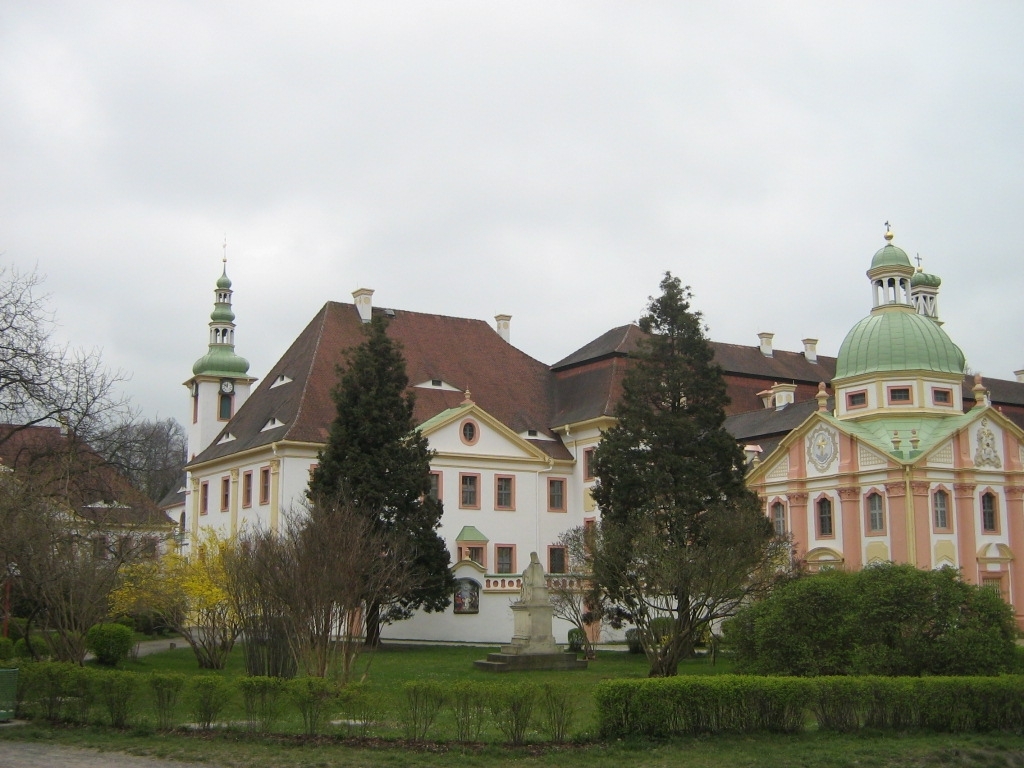St. Marienthal Abbey on:
[Wikipedia]
[Google]
[Amazon]
St. Marienthal Abbey (; ) is a Cistercian nunnery in Saxon
 The abbey was founded in 1234 by Kunigunde of Hohenstaufen, daughter of Philip of Swabia and wife of Wenceslas I of Bohemia, near a trade route that ran from Prague to Görlitz via Zittau. As early as 1235 the new foundation was incorporated into the Cistercian Order, with the abbot of Altzella acting as visitor. The first documented abbess of St. Marienthal Abbey was the noblewoman Adelheid I. von Dohna (Donyn), daughter of Burgrave Otto von Dohna (Donyn).
The abbey was destroyed during the Hussite Wars in 1427, and not rebuilt until 1452. It was damaged by fire in 1515, 1542 and (particularly seriously) in 1683. Rebuilding in the
The abbey was founded in 1234 by Kunigunde of Hohenstaufen, daughter of Philip of Swabia and wife of Wenceslas I of Bohemia, near a trade route that ran from Prague to Görlitz via Zittau. As early as 1235 the new foundation was incorporated into the Cistercian Order, with the abbot of Altzella acting as visitor. The first documented abbess of St. Marienthal Abbey was the noblewoman Adelheid I. von Dohna (Donyn), daughter of Burgrave Otto von Dohna (Donyn).
The abbey was destroyed during the Hussite Wars in 1427, and not rebuilt until 1452. It was damaged by fire in 1515, 1542 and (particularly seriously) in 1683. Rebuilding in the
St. Marienthal Abbey official websiteInternational Meeting Centre with conferences and workshops St. MarienthalServices of St. Marienthal (spirituality, accommodation, education, shop, sightseeing tours, food)
{{DEFAULTSORT:Marienthal Abbey 1230s establishments in the Holy Roman Empire 1234 establishments in Europe Cistercian nunneries in Germany Monasteries in Saxony Christian monasteries established in the 1230s Görlitz (district)
Upper Lusatia
Upper Lusatia (, ; , ; ; or ''Milsko''; ) is a historical region in Germany and Poland. Along with Lower Lusatia to the north, it makes up the region of Lusatia, named after the Polabian Slavs, Slavic ''Lusici'' tribe. Both parts of Lusatia a ...
. The abbey is the oldest nunnery of the Cistercian Order in Germany to have maintained unbroken occupation of its house since its foundation.
St. Marienthal is located to the south of Ostritz on the left bank of the Neisse, which at this point forms today's German border with Poland. To the north, Görlitz is about 20 kilometres away.
History
 The abbey was founded in 1234 by Kunigunde of Hohenstaufen, daughter of Philip of Swabia and wife of Wenceslas I of Bohemia, near a trade route that ran from Prague to Görlitz via Zittau. As early as 1235 the new foundation was incorporated into the Cistercian Order, with the abbot of Altzella acting as visitor. The first documented abbess of St. Marienthal Abbey was the noblewoman Adelheid I. von Dohna (Donyn), daughter of Burgrave Otto von Dohna (Donyn).
The abbey was destroyed during the Hussite Wars in 1427, and not rebuilt until 1452. It was damaged by fire in 1515, 1542 and (particularly seriously) in 1683. Rebuilding in the
The abbey was founded in 1234 by Kunigunde of Hohenstaufen, daughter of Philip of Swabia and wife of Wenceslas I of Bohemia, near a trade route that ran from Prague to Görlitz via Zittau. As early as 1235 the new foundation was incorporated into the Cistercian Order, with the abbot of Altzella acting as visitor. The first documented abbess of St. Marienthal Abbey was the noblewoman Adelheid I. von Dohna (Donyn), daughter of Burgrave Otto von Dohna (Donyn).
The abbey was destroyed during the Hussite Wars in 1427, and not rebuilt until 1452. It was damaged by fire in 1515, 1542 and (particularly seriously) in 1683. Rebuilding in the Baroque
The Baroque ( , , ) is a Western Style (visual arts), style of Baroque architecture, architecture, Baroque music, music, Baroque dance, dance, Baroque painting, painting, Baroque sculpture, sculpture, poetry, and other arts that flourished from ...
style began in 1685. The Baroque church interior suffered extensive damage in a flood of the Neisse in 1897.
During World War II
World War II or the Second World War (1 September 1939 – 2 September 1945) was a World war, global conflict between two coalitions: the Allies of World War II, Allies and the Axis powers. World War II by country, Nearly all of the wo ...
the buildings were used as a military hospital. In 1945 the retreating German forces wanted to blow up the abbey to hinder the advance of the Russians, but the nuns refused to leave, and the building was spared.
The abbey survived the Communist East German régime and after 1989 spent large sums on restoration and developing the facilities. In August 2010 however another flood of the Neisse caused catastrophic damage.
Bibliography
* Dannenberg, Lars-Arne (2008): ''Das Kloster St. Marienthal und die Burggrafen von Dohna''. in: Neues Lausitzisches Magazin 11 (2008), pp. 89–104 * Schlesinger, Walter (ed.) (1965): ''Handbuch der historischen Stätten: Sachsen''. Stuttgart * Schmacht, Josefine (2004): ''Die Zisterzienserinnen-Abtei St. Marienthal von 1800 bis 2000 im Spiegel ihrer Äbtissinnen''. StadtBILD-Verlag: Görlitz * Schönfelder, J.B. (1834): ''Urkundliche Geschichte des Königlichen Jungfrauenstifts und Klosters St. Marienthal in der Königlich-Sächsischen Oberlausitz''. Zittau * Zdichynec, Jan (2003): ''Klášter Marienthal mezi králi, městy a šlechtou (1234–1547)''. In: Bobková, Lenka (ed.): Korunní země v dějinách českého státu, vol. 1: Integrační a partikulární rysy českého státu v pozdním středověku, pp. 166–218. PragueReferences
External links
St. Marienthal Abbey official website
{{DEFAULTSORT:Marienthal Abbey 1230s establishments in the Holy Roman Empire 1234 establishments in Europe Cistercian nunneries in Germany Monasteries in Saxony Christian monasteries established in the 1230s Görlitz (district)